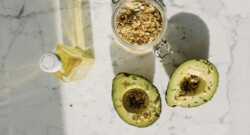Author: Tamara Mrázová
Are you thinking of getting a tattoo? Read this first!
A tattoo today is more than just body art—it’s a way to express yourself or capture important life moments. For some, it symbolizes freedom; for others, it’s a memory of someone special or simply a style choice. What was once seen as rebellious is now a normal part of life for many. If you’re trying to decide whether to get a tattoo, there are a few things you should think about first. Hopefully, these tips will help you make up your mind. Placement Carefully consider where you want your tattoo. It’s not just about how it looks and whether it will be visible, but also about how sensitive the area is. Think about your pain tolerance because of nerve endings and the thinness of the skin. The most sensitive spots are the ribs, ankles, neck, inner thighs, hands, and fingers. Artist Art isn’t just limited to paintings, music, or poetry—tattoos are definitely a form of artistic expression too. Just like other artists, tattoo artists have their own unique style. Make sure you’re 100% happy with the artist’s style before committing. Even if you bring your own design, the final tattoo might have slight variations. Health Risks Before getting a tattoo, it’s a good idea to check if you have any allergies to the ink or other materials that will be used. If you have any health conditions, be sure to consult your doctor first. Aftercare A tattoo is a permanent change to your body, so it would be a shame if it got ruined by improper care. You might get a lot of different advice, but trust what your tattoo artist recommends and follow their instructions closely. Removing a Tattoo Hurts More Than Getting One While many believe that tattoos are permanent, modern techniques have made removal possible. You can use a special laser to “burn” a tattoo off your skin. However, most people say that the removal process is more painful than getting it in the first place. So, think carefully about whether it’s worth it for you. “MY BODY IS MY JOURNAL, AND MY TATTOOS ARE MY STORY.” – JOHNNY DEPP
How to prepare yourself for back to school
It’s that time of year again—time to start off another school year! Organization and preparation are essential for a successful return to school. Students who are well-organized get better grades, experience less stress, and have greater confidence. However, it’s normal for kids (and their parents) to feel anxious about returning to school. Read on if you want to know how to start the school year on the right note. Establish a daily routine and stick to it As summer winds down, it is important to re-establish your routine. Have you ever noticed that the anxiety that stems from being late or forgetting your homework can ruin your entire day? This can be avoided by simply following a basic routine that would include doing homework, brushing your teeth, showering, etc. Establishing a daily routine will help you stay motivated and rested as you work through your workload. Make a to-do list Your to-do list can contain tasks you want to complete within a certain amount of time, such as chores, homework, test preparation, healthy habits, and creative projects. Choose whether you want to set your goals for each day, month or year. Make it creative so that is helpful, but also fun. Afterall, a to-do list might help boost your productivity. Create your own study place You can easily lose focus by digging through a cluttered desk or listening to your family members as they converse. Find a clean and quiet area in your house where you can sit and study or complete homework. Keep all the distractions, such as your phone, out of sight. Instead of sitting in bed which could make you sleepy, opt for sitting at a desk with a comfortable chair. Go shopping for supplies One of the most fun things on back to school might be shopping for new school supplies. Pick out a new school bag, notebooks, binders, pens and highlighters that will help you stay organized. A little shopping spree could boost your excitement and make you feel better prepared. Find ways to manage stress School can be stressful, no matter if you are 10 or 20 years old. Keeping the stress at bay is very important for your health and future success. If your find yourself overwhelmed with stress try to step back, take a deep breath and recognize your feelings. Sometimes stress might get too difficult to handle, in case it happens do not be ashamed to seek help. “Let us remember: One book, one pen, one child and one teacher can change the world.” – Malala Yousafzai
Car to Donate for Ukraine’s Victory
The team is transferring cars for the needs of the Armed Forces of Ukraine and Ukrainian rescuers and doctors. Since the beginning of the full-scale war, the transfer of 40 vehicles from Spain, Italy, and Poland has been organized. One car from Ukraine and one from Germany were given to the team as gifts. These cars have already been transferred. In addition, the team helps organise the purchase, maintenance, and transfer of vehicles to other volunteer groups on a turnkey basis. More than 100 000 euros (about UAH 4 000 000) have been entrusted to us in one form or another. The founders of the organisation post all the reports on their Facebook page. There you can find photos and a complete spending history with costs and receipts there. We are grateful to All People Who Make Donations, the Team, our Partners, and everyone who spent at least a minute of their time or one hryvnia from their budget for a common cause. And we keep going! If you have a car that you want to donate to save lives in Ukraine, we are ready to provide the whole process on a turnkey basis: paperwork; transfer; maintenance; report. We guarantee that the car will be transferred as a form of humanitarian aid, and we will provide the donor with all subsequent documentation and reports. At the donor’s request, we can indicate their name on the car and social networks. If you want to help, you can fill out the form at https://cartodonate.com/, and we’ll contact you for further details. You can also help the project by providing financial help: UAH PRIVAT: 5168752005654333 UAH MONO: https://send.monobank.ua/jar/83LXbxULEC USDT TRC20: TMVRCJuLFvrBWzxdhuccp8dUgfcbkhU49j Paypal: lushin.alexandr@gmail.com
Entrepreneur Irina Arsene: Supporting someone can change their life
“When someone comes to me and tells me that I’ve changed their life, it fills me with gratitude knowing I have such an impact,” says Irina Arsene, a Romanian entrepreneur who leads Mindit, a company with over 250 engineers. Mindit.io’s vision is to become the partner of choice for software product engineering and to offer specialized support teams for international companies. Irina started in Romania, but today she lives in Switzerland with her two children while continuing to run her successful business. What was the initial idea behind your business? Have you always wanted to be an entrepreneur? If I had to say what defines me, it’s the process of learning. I’m a ‘life explorer.’ Ten years ago, I started in the HR business, but I’m a computer science engineer, and since 2015, I’ve been in the software business. I love sitting in front of a computer and creating something out of nothing. It’s beautiful and fascinating. For me, programming is amazing; it involves a lot of creativity. I enjoy finding potential in people who don’t see it in themselves and supporting them. When you support someone, you can change their life. I believe no one is perfect, and we shouldn’t focus on our weaknesses but rather on our strengths. That’s where growth happens. By the time I was thirty, I already had a great career and two wonderful children. I realized how fantastic my life was and wanted to help others achieve the same. I discovered that my strengths lie in business and helping others. When someone comes to me and tells me that I’ve changed their life, it fills me with gratitude knowing I have such an impact. What led to the founding of your company? I founded it in 2015. We specialize in software development and employ over 250 people. Also, we run an HR company, which is a completely different field from IT. We operate in Switzerland, Germany, and partly in Austria. What’s important to me is that we function as one team and it’s not just about providing services. When you put both your mind and heart into something, it creates something magical. It’s not just code; it changes people’s lives. We have skills that we develop and think about how to use them. To create something meaningful, you need to invest a piece of yourself into it. With today’s fast technology development, what do you think is the future of AI? Will there still be a need for programmers eventually? People will still be needed. I don’t see AI as a threat; I see it as an opportunity. It’s all about the mindset—seeing the possibilities that artificial intelligence brings. I view it as a chance to create innovative and intelligent solutions. While some people live in the past and reminisce about how things were when they were younger, I have the opposite problem: I live in the future. I should focus more on enjoying the present moment. But I’m someone who’s always dreaming. When I want to do something, 80% of it happens in my mind and only 20% is in the actual task. Recently, you posted on LinkedIn saying you’re a ‘future astronaut.’ Could you explain that further? When I was a child, I wanted to be an astronaut. I started in a small town in Romania, in a poor family. It seemed impossible at the time. But nothing is impossible. People say, ‘The sky is the limit,’ but for me, not even the sky is the limit. I’m proud of my Romanian heritage and the educational system where I learned so much. But there’s also a beautiful world outside with many opportunities. The more you learn and discover, the more you realize that people are similar despite different cultures, religions, locations, and industries. We all ask the same questions: How to be a better parent? How to be a better person? What is the meaning of my existence? That’s the essence. I believe that when you step back and look at a person as a whole, it gives you a sense of unity. That’s why I would like to go to space—to see the world as one whole. I also ask existential questions about the meaning of life. My family and I have lived abroad for a while, facing challenges and integrating into a new culture, which wasn’t always easy. But it brought us closer together. You start focusing more on what connects you rather than what divides you. I love people and enjoy finding potential in those who don’t see it in themselves. You live in Switzerland but part of your team is in Romania, how do you co-work with them? During the pandemic, we were also separated and worked remotely. We had meetings to have a bit of fun. We enjoy meeting up for coffee and discussing ideas. I really miss the energy of being in the same room together. And I miss that energy when we’re apart. Balance between genders is important. It brings a fresh breeze into company. Yes, we’re complementary, and that’s a good thing. Given the chance, women can be excellent leaders even at the top management level. Family is very important to me. I believe you can have both a family and a career if you have support. You need support both at work and at home. For me, freedom means I don’t have to work, but I choose to because I want to do work that I’m passionate about. When I have a passion, I’m a better mom. Instead of just telling my children what to believe or how the world is, I show them that if they work hard, their dreams can come true. I lead by example and bring that passion into their lives. And when I’m with my kids, it’s not because I have to, but because I want to. What is the system like in Romania for mothers? Maternity leave is two years. I was a working mother, and I think the system is okay, but it’s focused on the mother rather than parenting as a whole. It’s embedded in our culture. There is pressure when a woman has a child; even in my own family, when I went back to work after three months, my sister asked me what kind of mother I was. Ironically, these questions often come from other women. I told my sister that I am the best mother my child could have. It’s about mindset. If we have a voice and influence, we need to educate people and talk about it. We should tell young people, colleagues, and women that if they want to support a young mother, they shouldn’t automatically push her towards motherhood but rather support her dreams and passions and listen to her. This way, she will become a better mother. Irina, what were the biggest challenges you faced building Mindit? We started from scratch, and the first two to three years were very tough. Every project was a ‘make it or break it’ situation. Every month that we managed to make payroll was a significant victory. Now we’re going through a transformation; we’re no longer a small company but a mid-sized one, so we need to establish different processes. But I’m excited about it. Everything depends on the team—everyone is important and on the same level; we don’t have a hierarchy. Everyone is part of one big flower, and we need everyone to make that flower beautiful. I believe in the future of our company because we are building it together. All I need to do is continue learning, inspiring others, and supporting my team throughout our ongoing process of growth. Aren’t you scared of leading a big company? I find intellectual stimulation in the idea that having a bigger business and larger numbers gives me the chance to have a greater impact. All limits are only as big as you set for yourself. I learn a lot from transformation, and as a company grows, you can’t avoid it. It’s about the joy of learning new things. I don’t set limits for myself, so big numbers don’t surprise me. I have the advantage of having the choice. Irina, what do you consider your biggest success by far? I view the entire process of building a business as a journey to success. But if I had to choose one event, it might be being named Inspiring Woman of the Year by Ernst & Young. I received this award earlier this year in Romania. Or perhaps the fact that I’ve been in business for 10 years. I don’t need external validation. I do it to make an impact. But the best part is enjoying the journey and knowing that what you do is meaningful to others. When I accepted the award, I stood on stage as the only woman among about twenty men, and I thought there should be more women up there. If I can inspire even one woman, I would consider that a win. How would you advise women working in a business environment? I don’t like to give advice because everyone has to find their own answers within themselves. But reflecting on my own journey, I’ve found that when I focused on what was important to me and believed in it, I simply couldn’t give up. People often fear declaring what their life’s purpose is or what their business is about. You need to find your sense of purpose or something that drives you forward and not give up. It doesn’t matter what others think. Be true to yourself, stand by your truth, and follow your passion. Some may leave you, but others will join you, and you’ll discover beautiful things in these people, in the world, and within yourself.
Avocado on our plates. 3 awesome recipes from it!
Avocado made its way to us all the way from Central and South America. A perfectly ripe avocado is known for its green color, creamy texture, and a wealth of nutrients that are good for you. It’s packed with minerals and vitamins like C, K, E, and B6. In today’s article, we’ll explore how we can incorporate avocado into our dishes. Guacamole isn’t the only tasty dish you can make with it. Whether you’re craving something sweet or savoury, you’re in the right place! Avocado soup This quick and amazing recipe is perfect for lovers of creamy soups. You’ll need one finely chopped onion, two cloves of garlic, heavy cream, two cups of homemade broth, lime juice, and, surprisingly, four avocados. Start by sautéing the garlic and onion in a pot with some oil, then add the broth and lime juice. Next, stir in the finely chopped avocado and season to taste. Before blending the mixture with an immersion blender, add the heavy cream and bring everything to a boil. For those who love a spicy kick, adding jalapeños is the perfect touch. You can also top the soup with seeds or toasted croutons when serving. Avocado ice cream Need to cool down? On these hot summer days, this treat will hit the spot. To make it, you’ll need two ripe avocados, a bit of dried ginger (but don’t overdo it), heavy cream—ideally with a high fat content—and an equal amount of milk, whichever type you prefer. The last ingredients are sweetened condensed milk and a pinch of salt. The preparation couldn’t be simpler. Blend everything together, pour the mixture into a container, and let it chill in the freezer for at least 3 hours. You can even leave it in the freezer overnight for an extra refreshing treat. Avocado caprese salad We’ll finish off our recipes with a light salad that has an intriguing flavor, thanks to a combination of ingredients you might not expect to taste so good together. For this salad, you’ll need arugula, spinach, mozzarella, a drizzle of balsamic vinegar, nuts—preferably pine nuts or walnuts—avocado, and the surprise ingredient: strawberries, which will add a unique twist to the flavor. For an extra touch, finely chop some mint and sprinkle it on top. Enjoy! 🙂
Famous Slovak actor Tomáš Sitkey: When the camera’s on, I’m in my element, doing what I was born for.
His dream job was acting, and that dream has become a reality. Actor Tomáš Sitkey, known from Slovak TV series, truly loves his work with all his heart. Recently, many have come to know him through Slovak series like Dunaj and Mama na prenájom, but these are just a few of the many projects Tomáš is involved in. In addition to acting, Tomáš started a business in financial services at a young age and has now become famous on social media as an influencer. He focuses on quality over quantity in his videos and strives to be original. His goal is to evoke emotions in his audience, usually joy and laughter, as his content tends to have a humorous tone. Tomáš, how did you get into acting? The first time I thought, “I could be an actor,” was when the talented actress Peťka Vajdová approached me and offered to help me prepare for the entrance exams to VŠMU (the Academy of Performing Arts). Her brother was my classmate in high school, and she had seen me perform in several skits at our graduation party. She thought I had talent. However, I didn’t get into VŠMU, and I was so disappointed that I convinced myself I had no potential. After that disappointment, I put acting aside for ten years. However, the desire to pursue it only grew stronger over time. I felt a strong need to act, so I started making funny videos on Instagram and TikTok to ease the pressure and find a way to express myself. Surprisingly, these videos quickly caught on. Even though I didn’t make a lot of them, they got decent views and positive feedback, and my fan base started to grow. The more it grew, the more I began to believe in my potential as an actor. When actors began reaching out to encourage me to take acting seriously, it didn’t take long for me to decide to go for it. Despite huge doubts and sometimes feeling paralyzed by fear, I decided to open the door to acting again after those 10 years. I went to a casting for a TV network’s actor database, and things took off from there. Which of the aspects of your job do you not enjoy? I really don’t like it when important information isn’t communicated clearly and things aren’t said outright. It’s an unfair approach, and actors sometimes face these kinds of issues. In the world of influencers, I also dislike having to manage the speed and length of videos just to maintain viewership. Sometimes, this compromises quality and creativity. I am proud that I’ve overcome my fears and I am doing what I’ve always dreamed of. Do you like creating content on social media? Even though I’m not very active in social media creation yet, I really enjoy it. I’m quite a creative person, and it’s great to have control over my own content. However, sometimes my videos get blocked due to today’s sensitive society and sometimes arbitrary social media policies. It’s a bit limiting, but I have to play with what I have the best I can. Anyway, since I love humour and it seems like a lot of people find me funny, it’s another way for me to express myself in acting, make people laugh, and spread good energy. Which social media platform do you like the best? I like Instagram the most, but I try to limit my content consumption and stick to a few selected profiles. The impact of social media on young people who are constantly glued to their screens can be really negative. They often struggle with personal interactions, have a confused view of reality, and by constantly consuming so much content, they overstimulate their dopamine receptors, which can make it hard for them to enjoy simple things and lead to anxiety. So, I’d say—everything in moderation! But, of course, keep following me! (laughs) Who is your biggest motivation and inspiration? I draw inspiration from a lot of people—family, friends, both famous and infamous personalities. But when I think about it, often my sources of inspiration aren’t people at all. As for role models, I don’t really have a specific one. I don’t want to live my life based on someone else’s example. However, if I had to mention specific people I admire and would like to be like in some aspects, it would generally be my father, as well as Lasica, Satinský, and Jim Carrey in the acting world. You entered the business sphere at the age of 18. What would you recommend to young people who want to start their own business? They should go for it despite their fear. Fear and doubt aren’t something you can just turn off with a switch. Either you gather the courage and move forward with the fear, or you don’t try at all. The feeling of not knowing how it could have turned out if you had tried is often worse than the fear itself. It’s not like you can wait until you’re no longer afraid before giving it a shot. A lot of young people today have anxiety about not knowing what they want to do with their lives. Because they’re constantly glued to Instagram, they often subconsciously compare themselves to all those people living their dreams, being successful, wealthy, happy, balanced, and amazing. But that’s just a huge illusion and far from reality. Everyone has doubts, struggles, and problems, even those who seem to have perfect lives on Instagram. That’s why I want to emphasise that it’s completely okay and normal not to know what you want to do with your life. It’s something to accept as a natural part of the process—don’t beat yourself up about it, don’t compare yourself to others. Try to listen to your inner self, soul, feelings, or intuition, whatever you want to call it, and experiment with what you feel might be ‘it’ for you.
The International Youth Day is held on August 12th. It is a celebration of our future!
Today’s youth are bursting with energy, creativity, and a strong desire to make the world a better place. They’re known for their ability to adapt to a fast-changing world and tackle challenges with innovative solutions. With a focus on sustainability, justice, equality, and technological advancement, they offer fresh perspectives that are essential for the future growth of our society. Walking with your head in the clouds, without solid ground beneath your feet. That’s one way to describe the carefree aspects of youth. Thanks to the UN, we celebrate International Youth Day every August. This year, on August 12th, we’ll mark 25 years of acknowledging the importance of our youngest generation. Historical Background It’s not just a day for any celebration. International Youth Day was established through a UN initiative, aimed at raising awareness about the issues and challenges relevant to young people. Just like every generation faces its own unique challenges, Generation Z is no exception. These are the people born between 1997 and 2012, who grapple with issues related to telecommunications, cyberbullying, technological addiction, and the many challenges of the digital age. Main Priority and Theme Every year, International Youth Day has its own theme, reflecting current issues and priorities. These themes are usually chosen based on global challenges of the time and are designed to address specific issues faced by youth. In past years, the themes have included: “Focusing on Mental Health: Youth, Work, and Well-being” “Creative Economy: Innovation and Youth Employment” “Human Rights: Ensuring Fair Access to Education and Employment” “Transforming Education: Youth for the Future” Theme for 2024 The theme for 2024 focuses on “Sustainable Future: How We Can Empower Young People to Become Leaders of Change.” This theme highlights the importance of involving young people in decision-making processes. With the overwhelming number of options available to today’s youth, there’s a growing challenge where young people often struggle to make decisions. Who would have thought that as our options increase, society might actually feel more constrained? Traits of Today’s Youth – What Gen Z Excels At! Multilingual Skills: Slovakia boasts a remarkably language-proficient young generation. Up to 85% of Slovak youth are fluent in more than one language, with 75% speaking English fluently. For comparison, only 45% of young people in Spain can speak English. Tech Savvy: Being glued to their phones isn’t just a bad habit. Young people today are masters of technology, utilizing all that it offers. Well-Educated: They pursue higher education, engage in various courses, and are keen on self-study. They’re always eager to learn something new every day. Mastery of Artificial Intelligence: It’s often said that those who can harness AI hold the keys to the future. Our jobs won’t be replaced by AI but by people who know how to use it. Fearless Individuality: Today’s youth embrace democracy and aren’t afraid to use it to their advantage. They have no fear of standing out, voicing their opinions, and being unique. Cultural Exploration and Travel: They use social media to connect with international friends and learn about different cultures. Staying in touch with the world, they’re not scared to travel and see things for themselves, embracing new experiences firsthand. And even though it sometimes seems like their world revolves around selfies and funny videos on social media, it’s important not to underestimate them. Young people are looking for ways to get things done, not excuses to avoid them. Let them explore, experiment, and most importantly, let them be young. Give them a voice and the importance they deserve. They’ve earned it.
Young people can definitely make money. Here are the top 5 wealthiest members of Generation Z today
Generation Z is one of the most talked-about topics today. This generation includes people born from the mid-1990s to 2010. They’re often known for their liberal approach to life, tech-savviness, frequent use of English slang, and strong sense of individuality. Simply put, Gen Z isn’t afraid to stand out. In this article, we’ll take a look at members of this generation who embraced challenges and, as a result, became some of the most successful entrepreneurs of our time. Here are the top 5 wealthiest Gen Z individuals on the planet: Kylie Jenner Kylie Jenner, born in 1997, is an American entrepreneur, model, and philanthropist. In 2015, she founded the cosmetics brand Kylie Cosmetics. After successfully selling out her first collection, she sold half of her company’s stake to a well-known company for around $600 million. Her net worth was very close to making her the youngest billionaire in history, but it turned out that the profitable transactions meant to put her on the billionaire list didn’t quite align with the rules. Currently, her net worth is estimated to be between $700 and $800 million. Emma Chamberlain Emma Chamberlain is a well-known entrepreneur, influencer, and businesswoman. Her humor has won the hearts of many fans, especially through her YouTube channel, where she has been posting funny videos since 2017. In addition to being the face of many campaigns and collaborating with several brands, Emma founded her own brand, Chamberlain Coffee. Currently, her net worth is estimated to be around $12 million, which is a truly impressive achievement for the 23-year-old Emma. JoJo Siwa JoJo Siwa is an American singer and actress who rose to fame primarily through the show Dance Moms. She has captured the hearts of many young girls with her music, and one of her most well-known songs is “Boomerang.” Her earnings from a successful YouTube channel have been bolstered by a series of her own products. Under her colorful brand, she sells clothing, toys, and accessories. Her net worth is approximately $20 million. Olivia Rodrigo We’ll stay in the music realm, thanks to American singer Olivia Rodrigo, who has achieved massive success in recent years. After a tough breakup, she channeled her pain into the hit song “drivers license.” The song quickly climbed to the top of streaming charts worldwide. Her success continued with the release of her album SOUR. In addition to her music career, Olivia is also known for her acting experience on the Disney Channel. At just 21 years old, her net worth is already around $21 million. Alexandr Wang After featuring four successful women, we’ll wrap up the article with a male Gen Z representative. Alexander Wang is the founder of Scale AI, a company specializing in artificial intelligence services. Given the high demand and necessity for this kind of technology in today’s digital age, Wang’s company has seen tremendous profits. Wang’s net worth has soared to $2 billion. Notable clients such as Uber, Toyota, and Airbnb have significantly contributed to the growth of his wealth.








